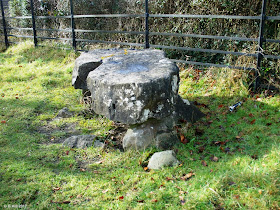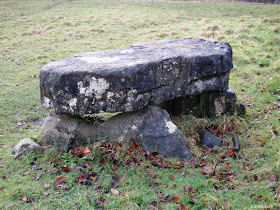Above Image: The entrance gate
Above & Below Images: The Nethercross
Above Image: entrance door
The history surrounding this abbey site stretches right back
to through the centuries when St Canice from Co Derry founded a monastery here in 560AD. He would later become the patron saint of Finglas. The
early monastery thrived for centuries but was laid open to many attacks by the
Vikings and virtually destroyed. It was rebuilt during the tenth and twelfth centuries and it is the ruins of these structures that we see
today. The abbey was suppressed during the dissolution of the sixteenth century under Henry VIII. Later during his daughter Elizabeth’s reign the
church ceased being a catholic place of worship and transferred to the
protestant community which it served until 1843 when a larger more modern
church was built. The abbey subsequently fell into ruin.
A visit to the ruins can only be made at certain times and outside of those you need to obtain a key to gain entry to the graveyard in
which the ruins lie. On my visit on a Sunday morning the gate was unlocked and
I had no trouble gaining entry. The ruins are extensive enough and you can walk
around them but sadly not enter as the entrance and windows have been barred
up. (I must enquire if there is a key available for here also) Nonetheless you can still see around the interior quite clearly. One very interesting
monument within the graveyard is a large Celtic cross known as the Nethercross.
The name derives from the barony of Nethercross but this ancient monument was
carved in the ninth century and stands seven feet high resembling the one actually carried by St Canice. It is the only remnant remaining from
the original monastery. During the Cromwellian invasion the locals dismantled
and hid the cross in a secret location fearing that the invaders would destroy
it. The cross remained hidden until 1816 when a clergyman named Robert Walsh
through dogged research eventually discovered its location through the oral
history of a local who's forebears passed the secret location down. Walsh had the cross
re-erected in the South East corner of the abbey grounds.
To find the ruins and cross take the junction 5 exit of the
M50 for city centre/Finglas. This leads onto the R135 (North Road). Continue on
until you reach a roundabout. Go straight through and approx. 500m later you will drive
under an underpass and subsequently an overhead footbridge. 140m beyond the
footbridge on the left there is a Permanent TSB bank with a small car park in
front and you can turn in here and park. Directly across the road you turned in
from is Wellmount Road. Simply cross over the road to it and on the corner
there is a line of stone cottages with a ramp leading up in front of them . At
the top of the ramp is the entrance gate to the graveyard. The gate is open on
Sundays and Bank Holidays from 10.30am-5.30am. Outside of these times you can
obtain a key from Thomas Lynch at 5 Barrack Lane which is one of the stone
cottages mentioned.


























